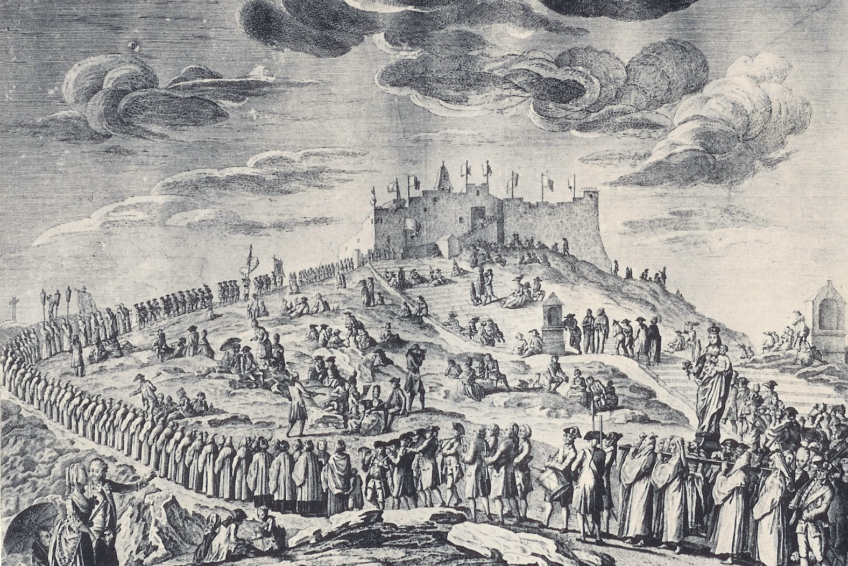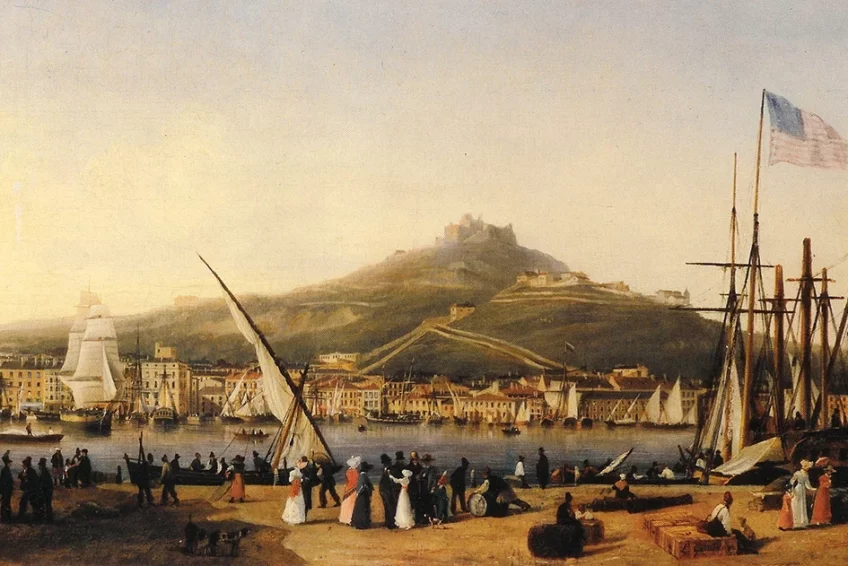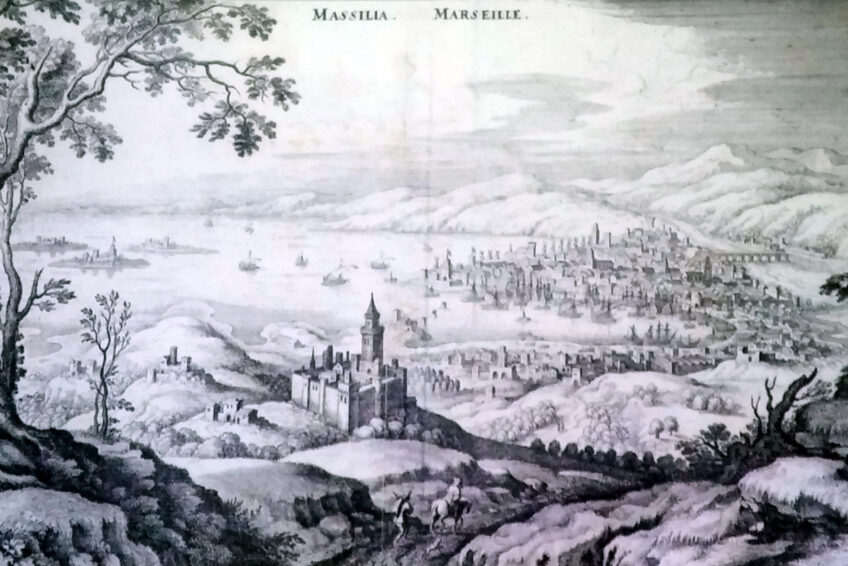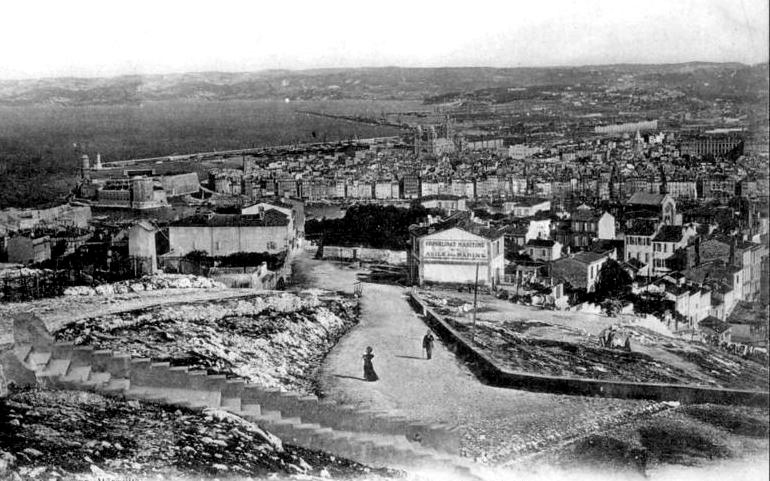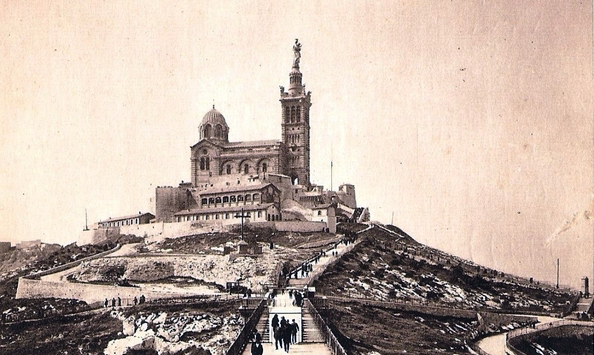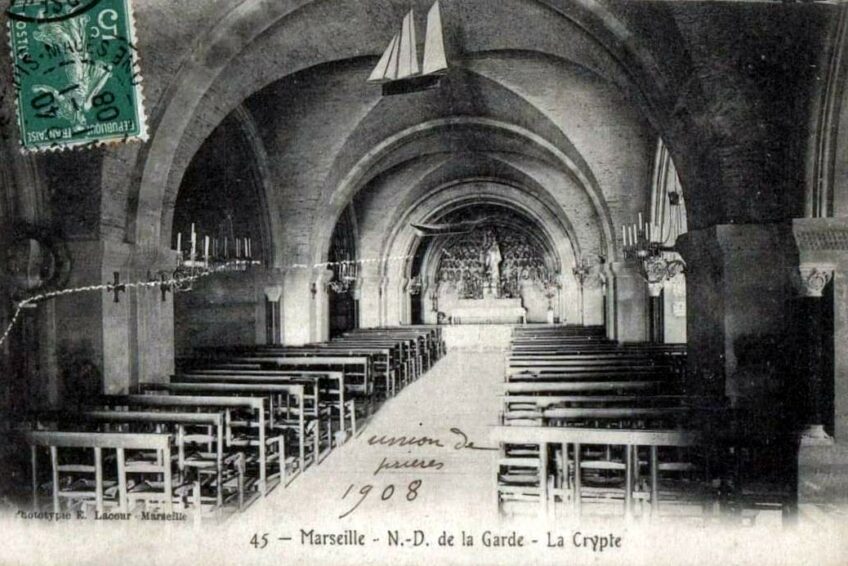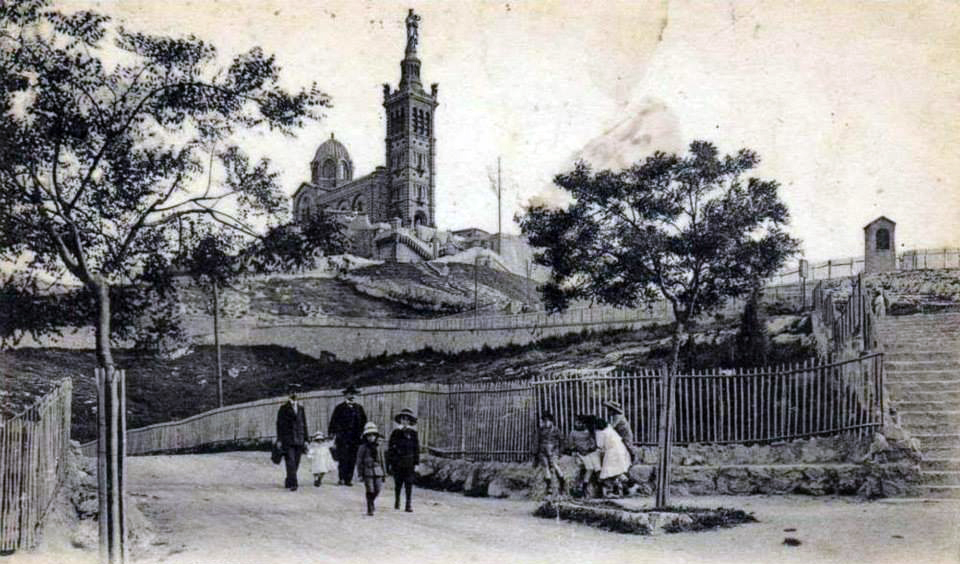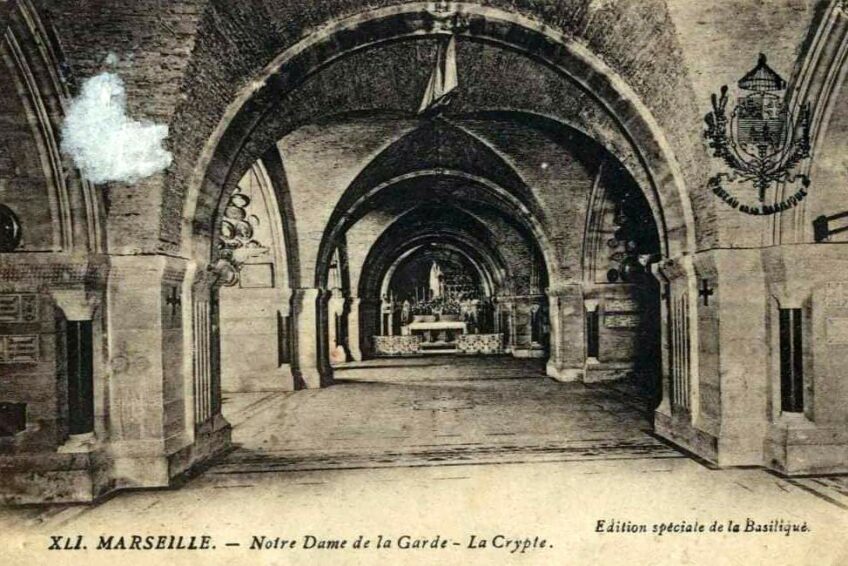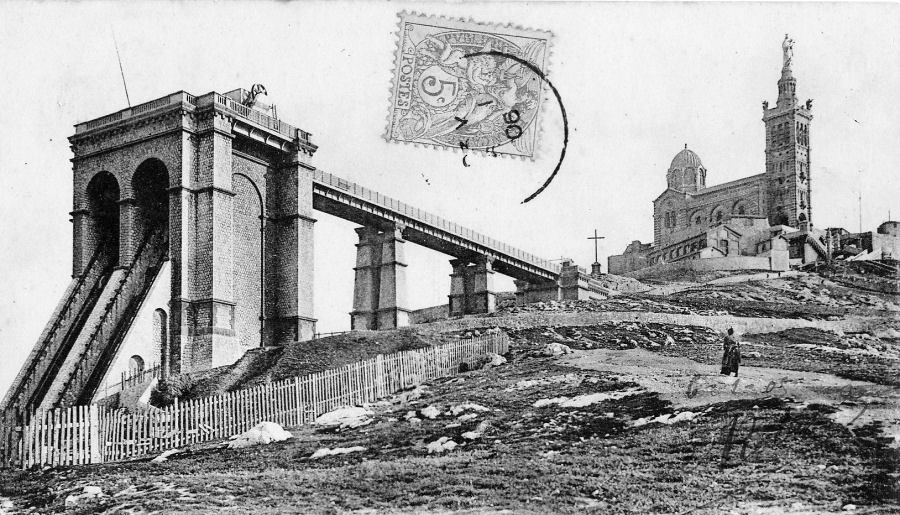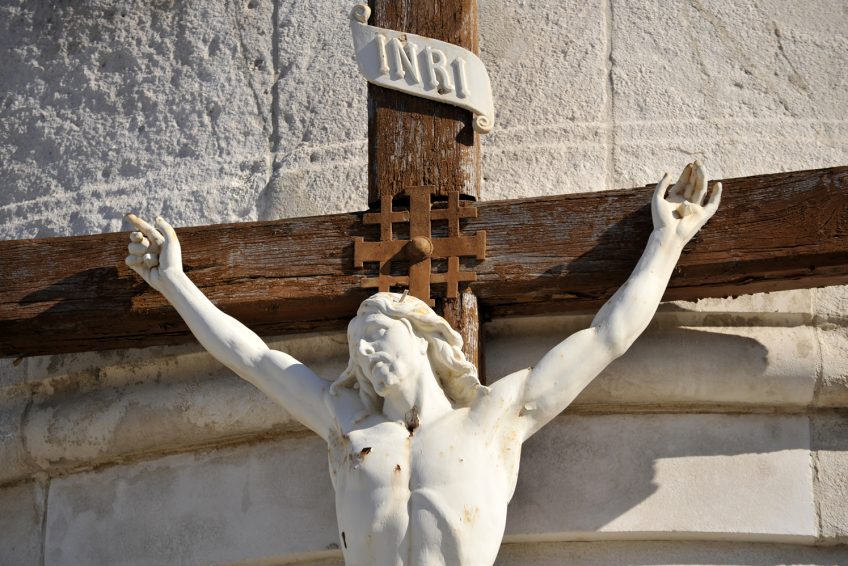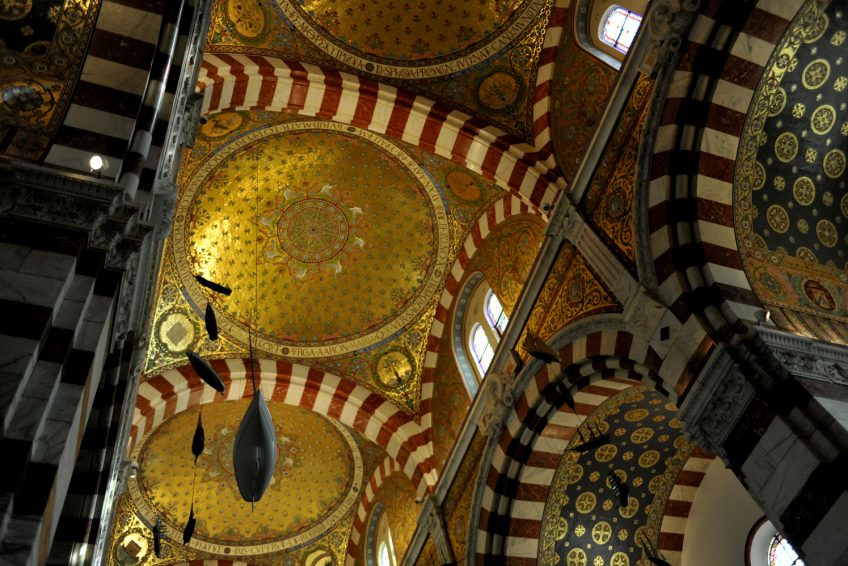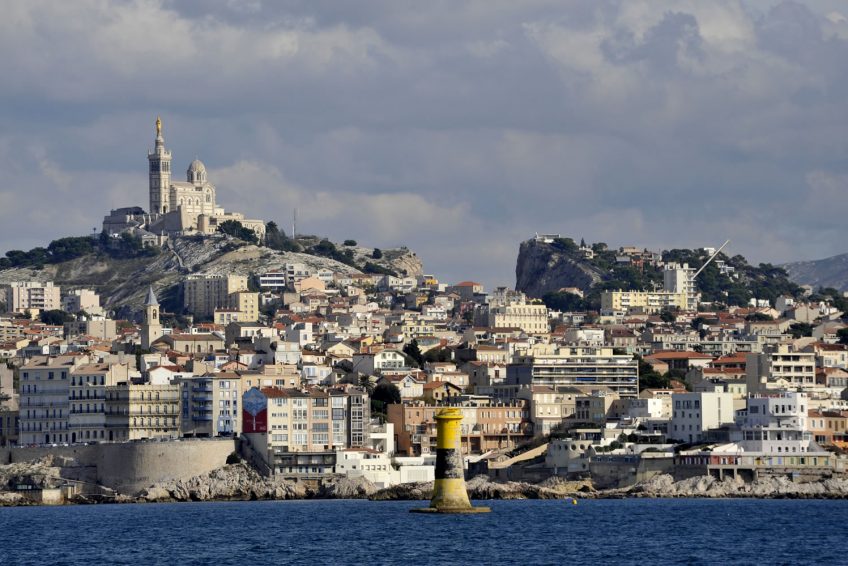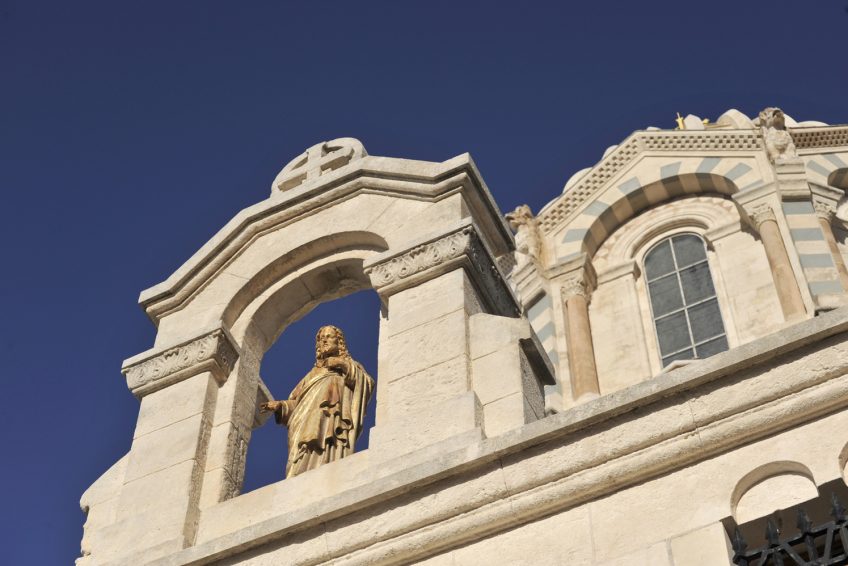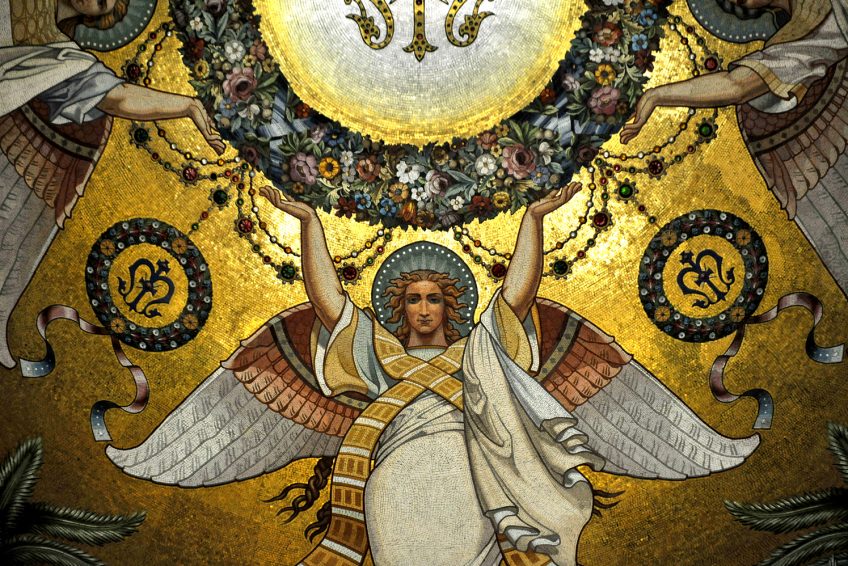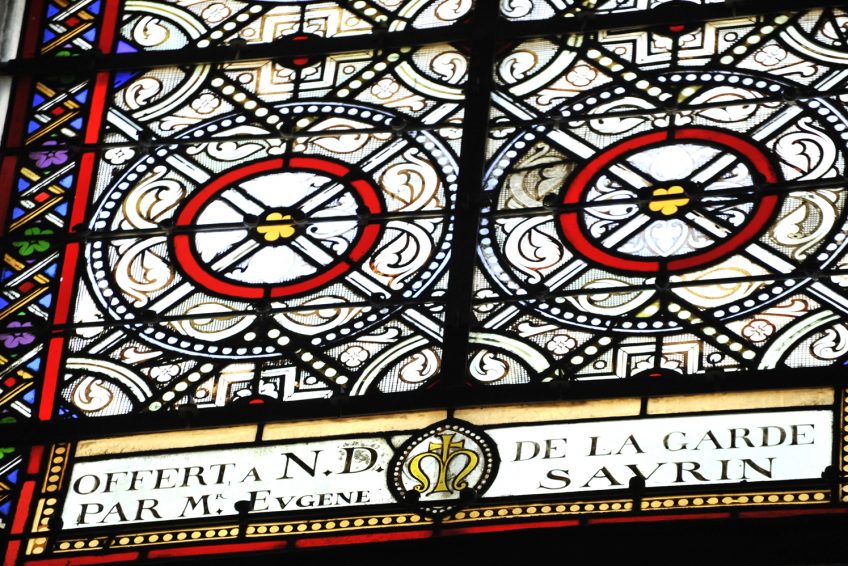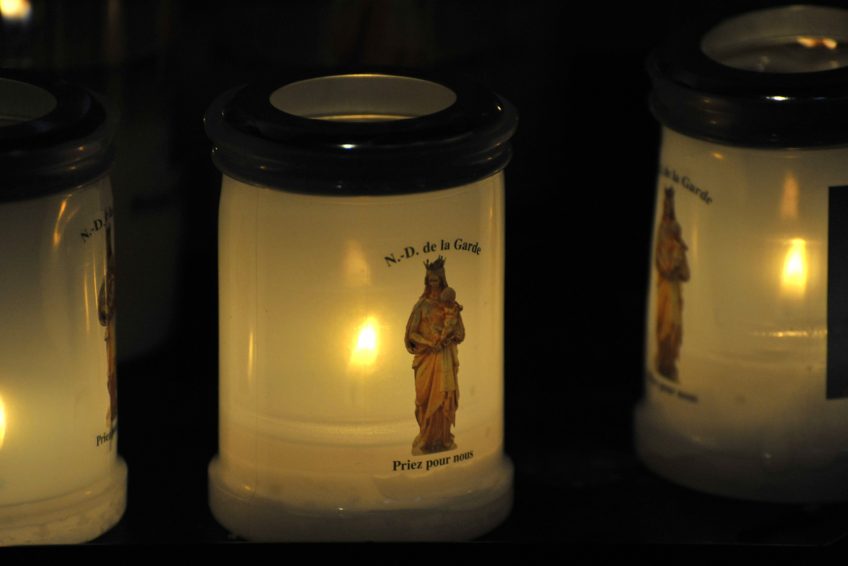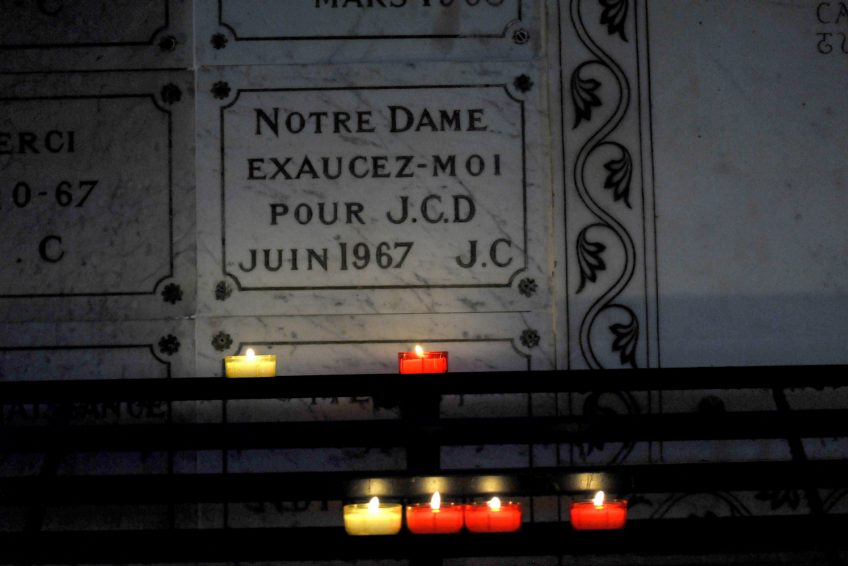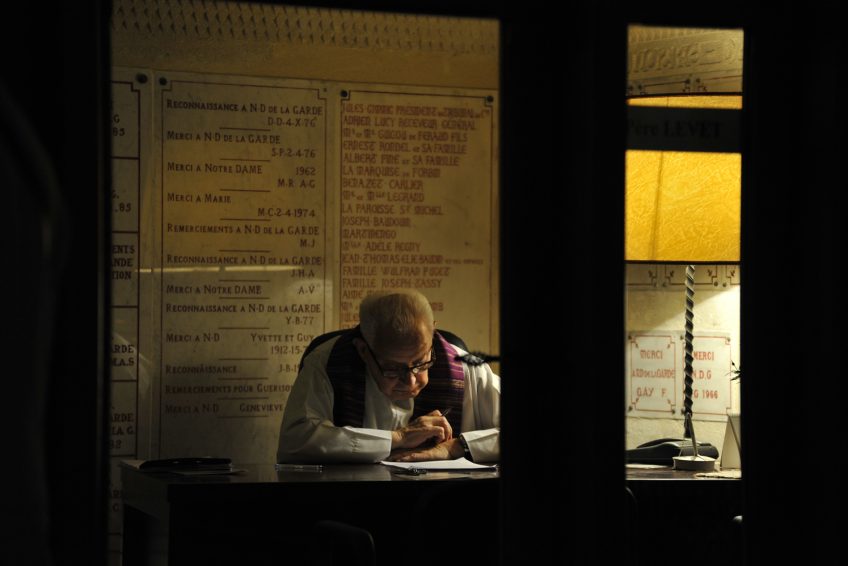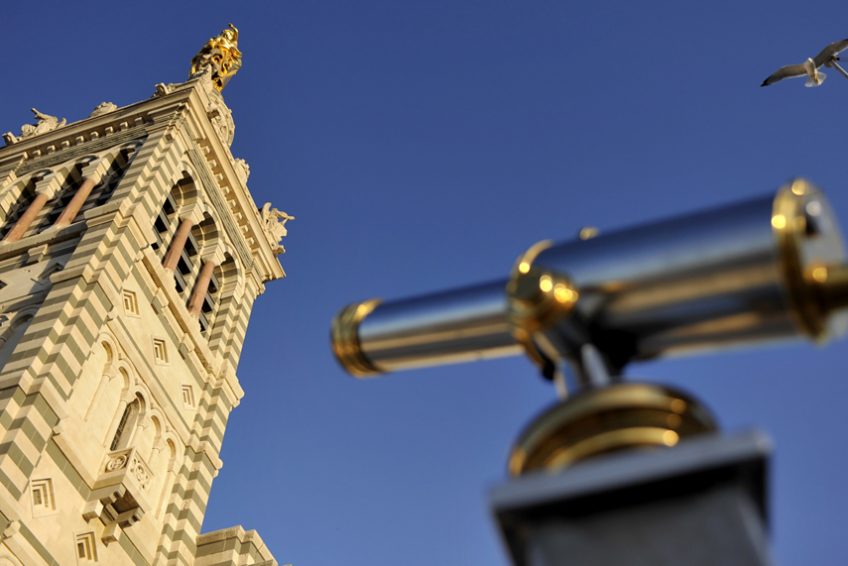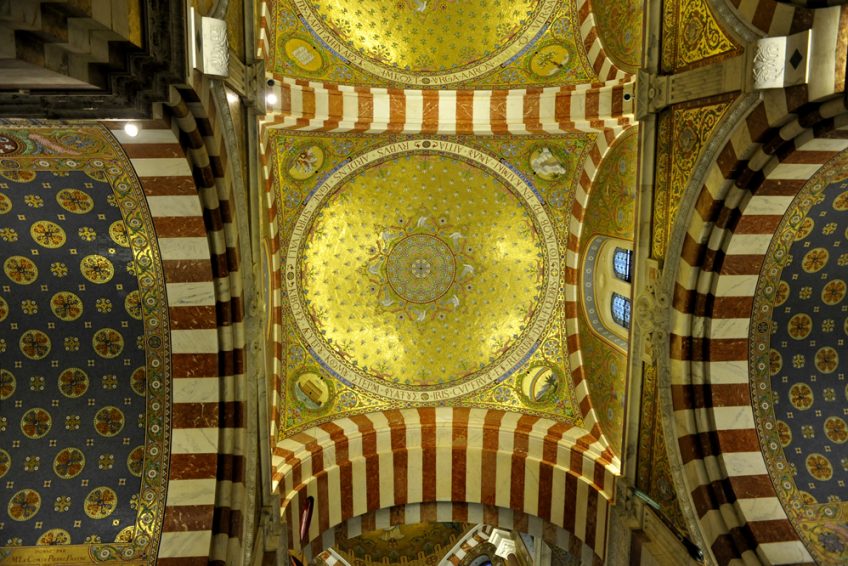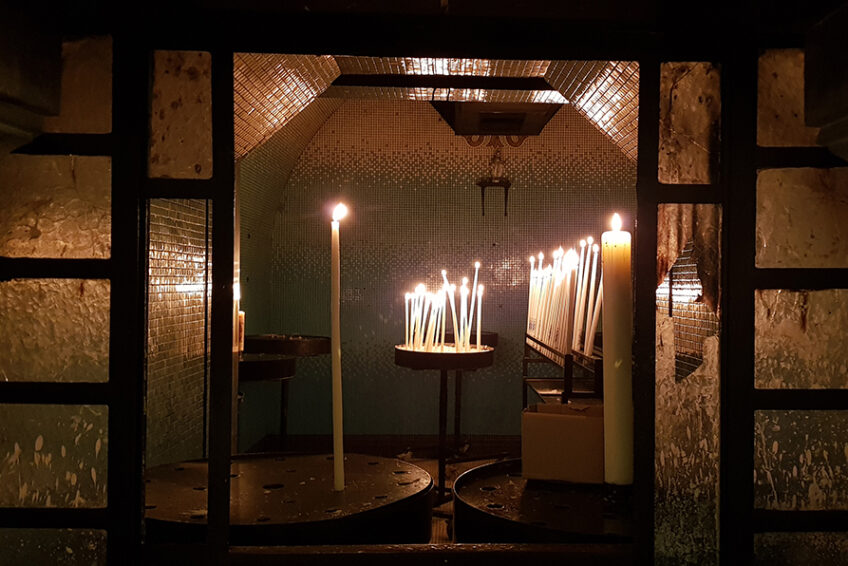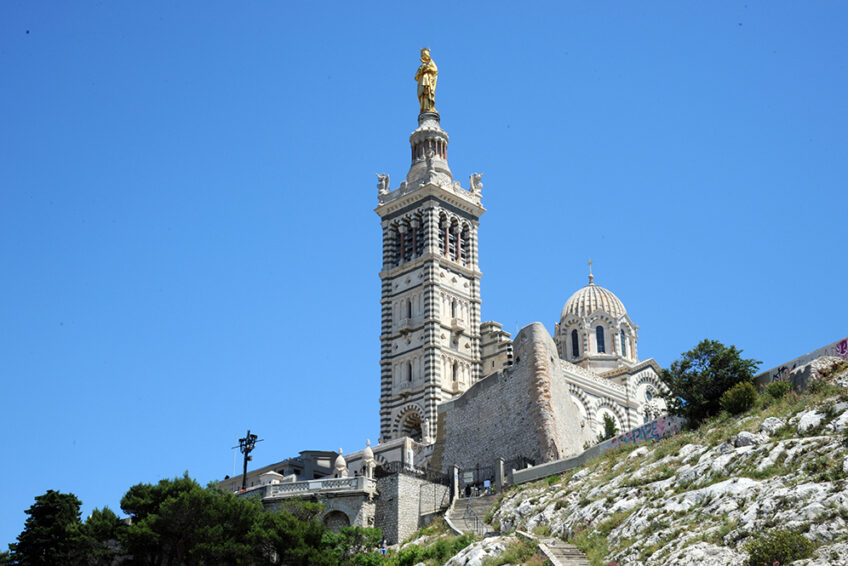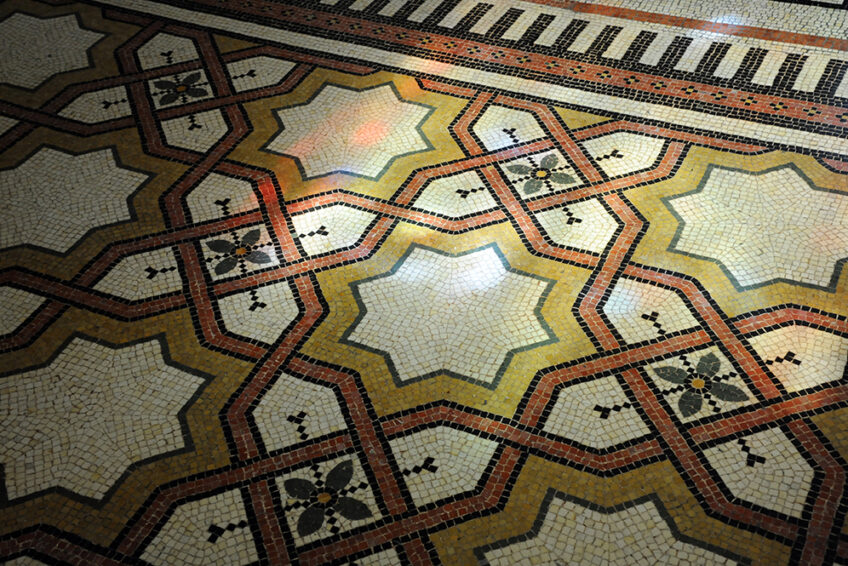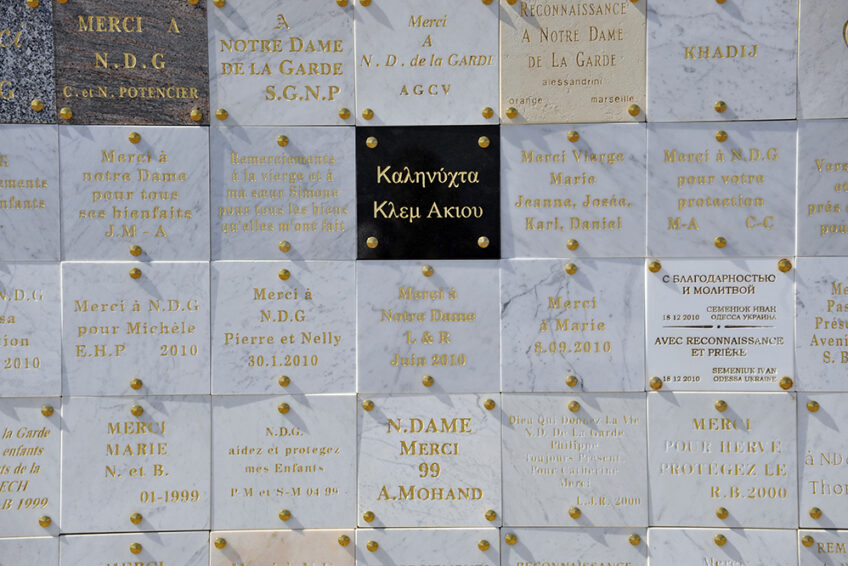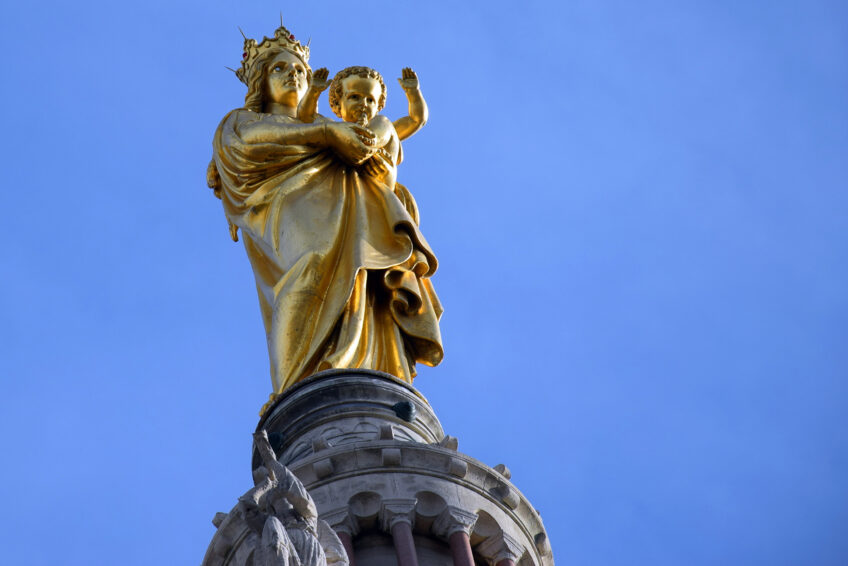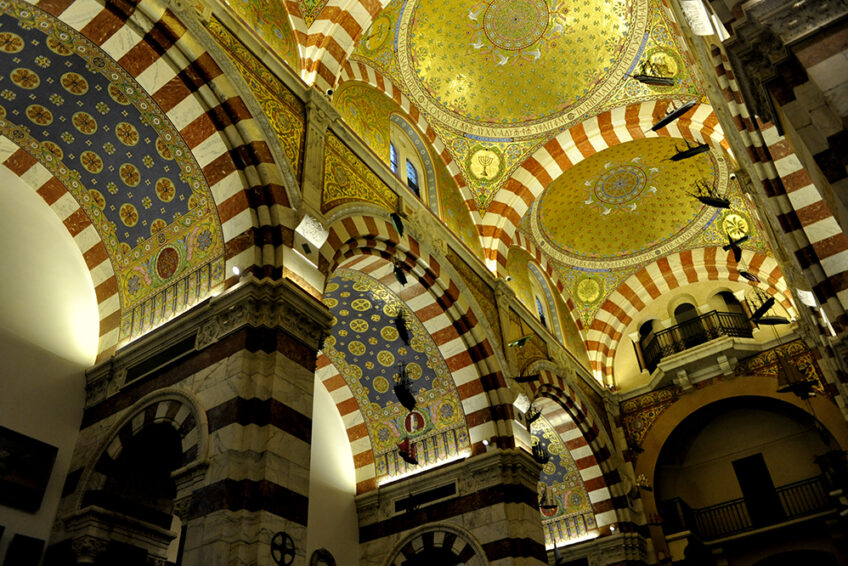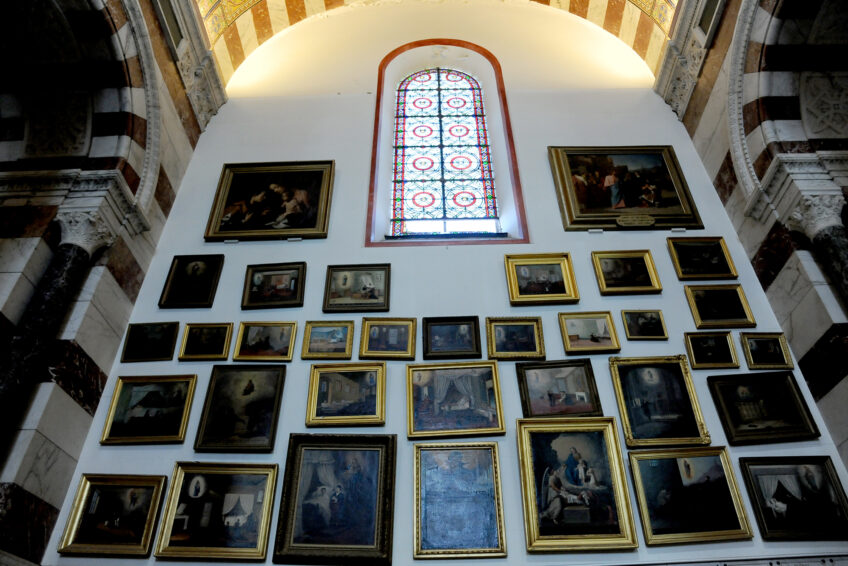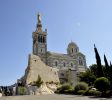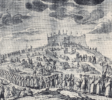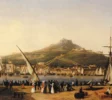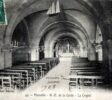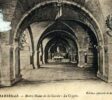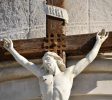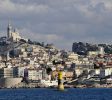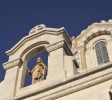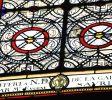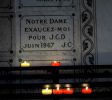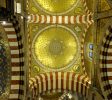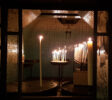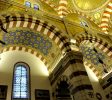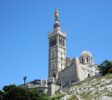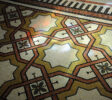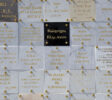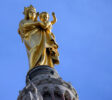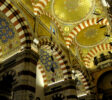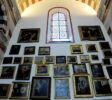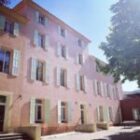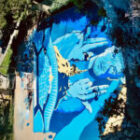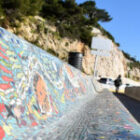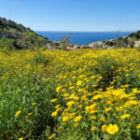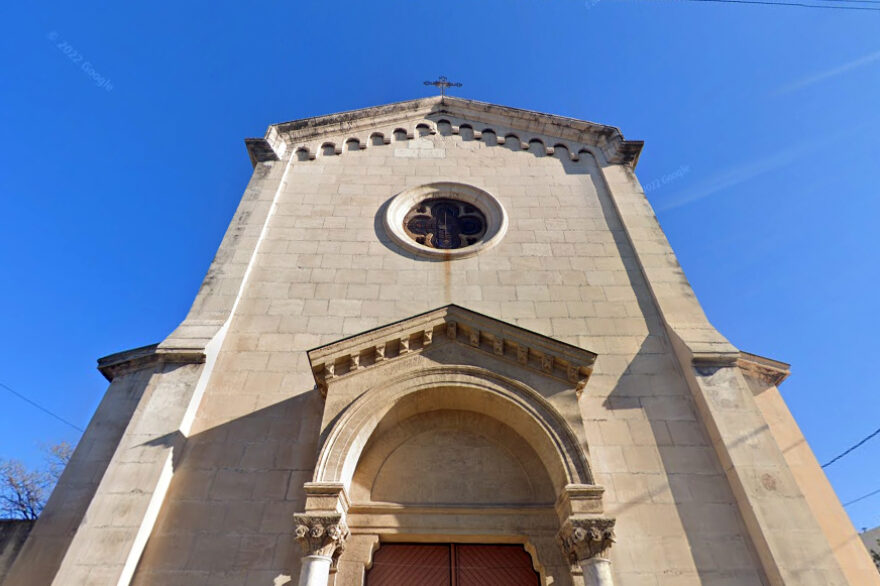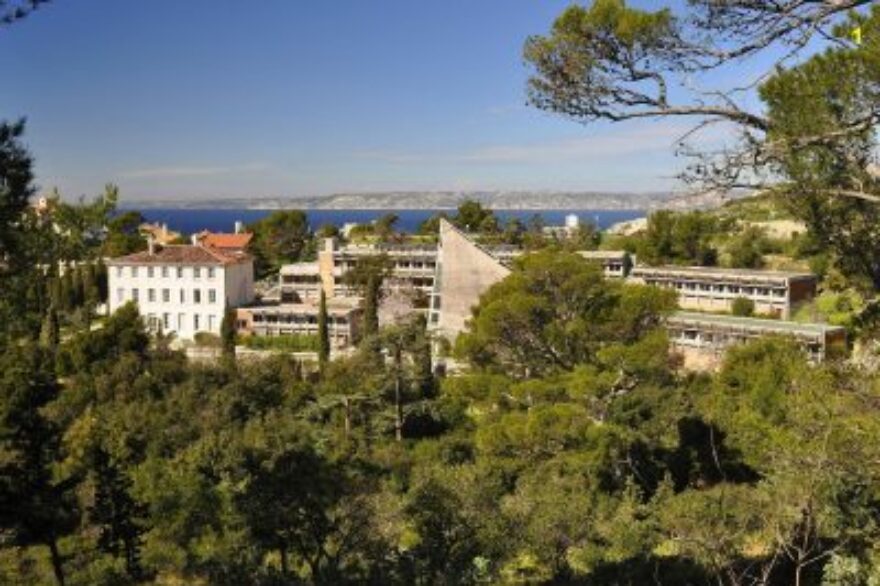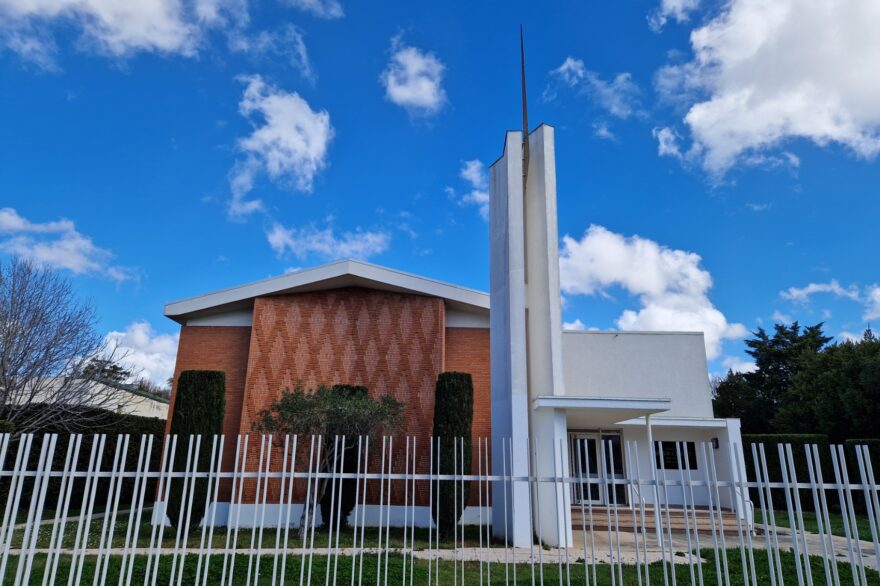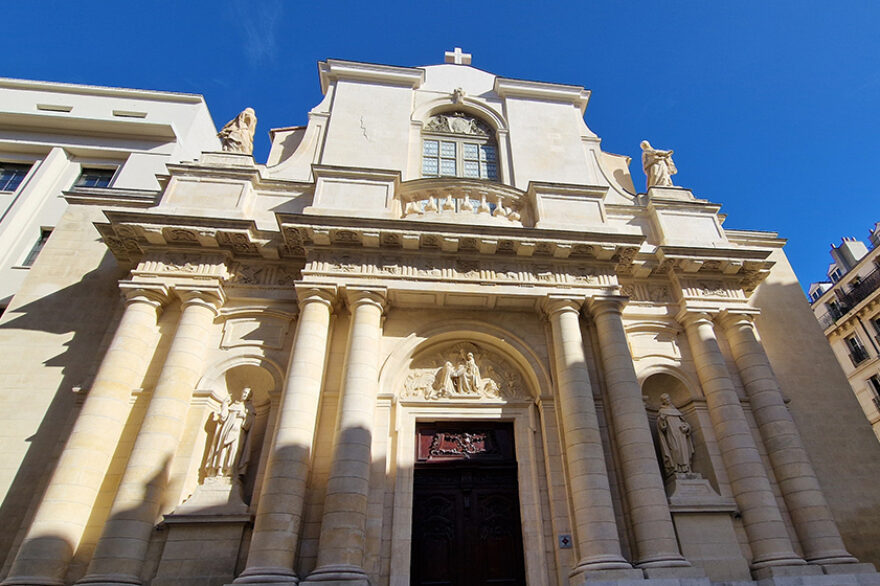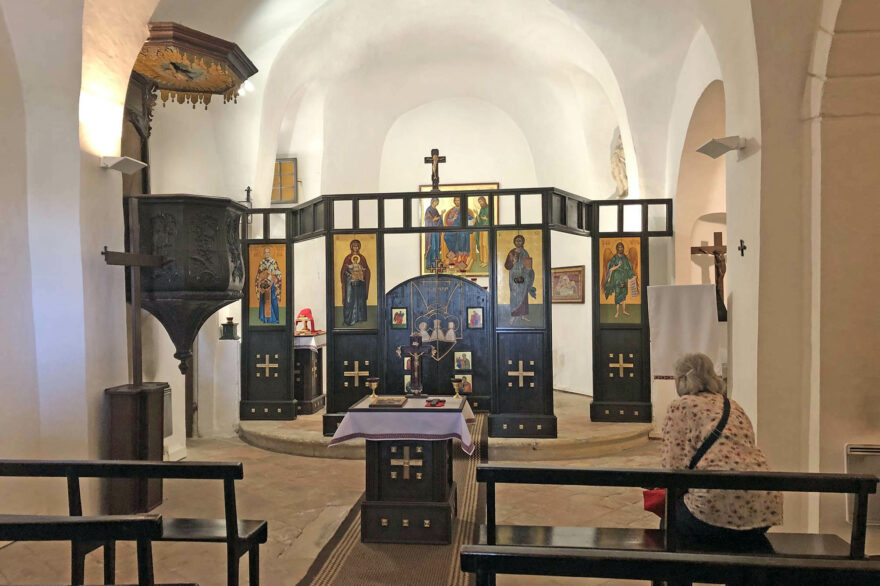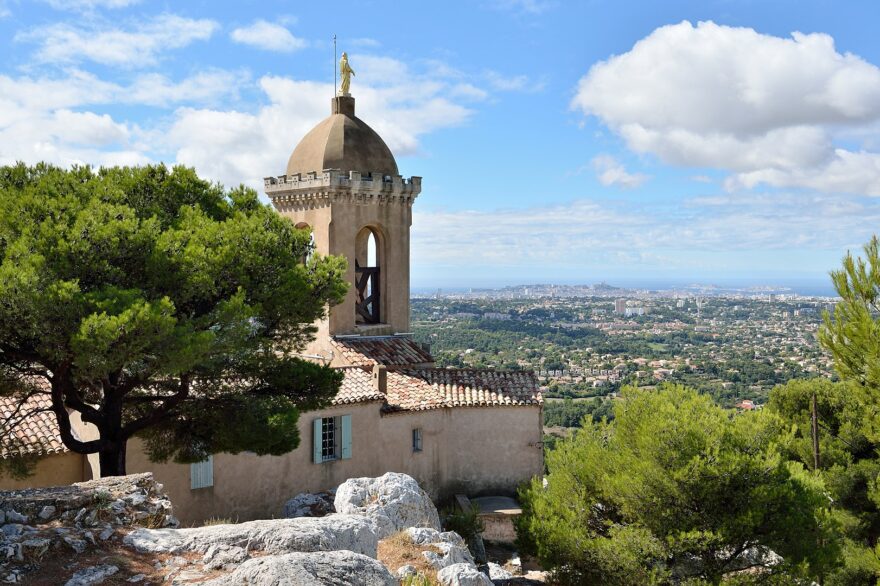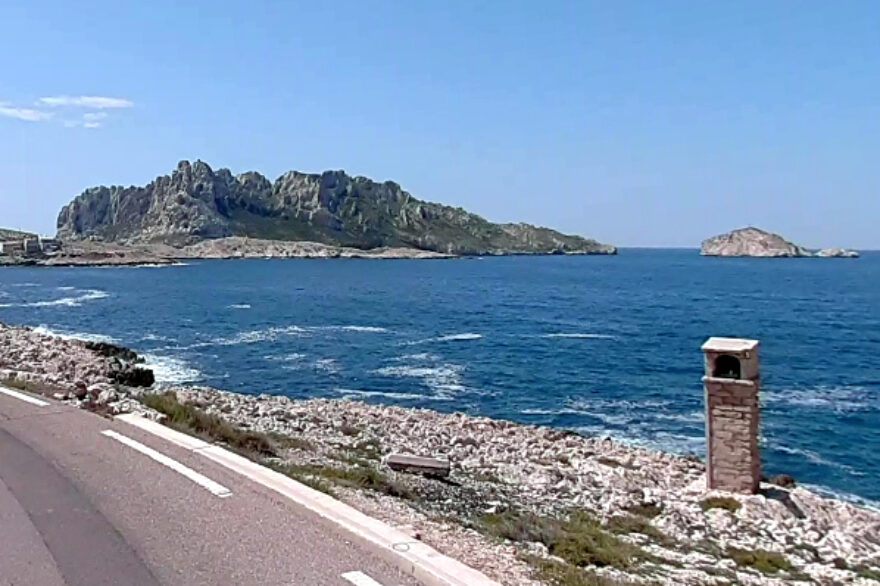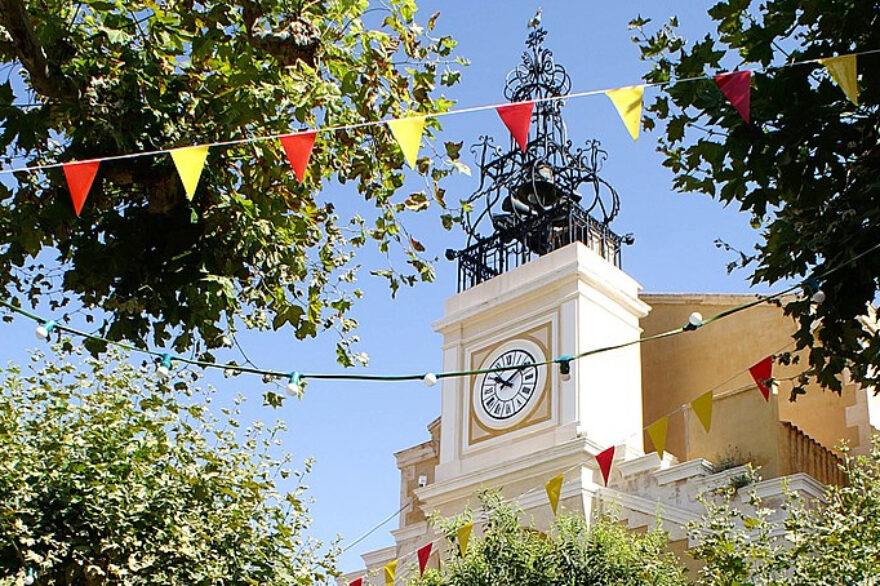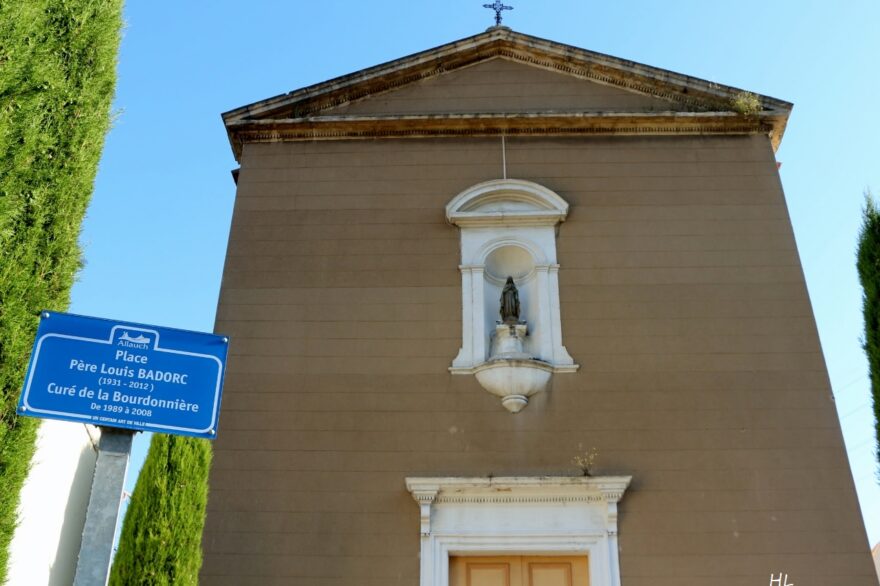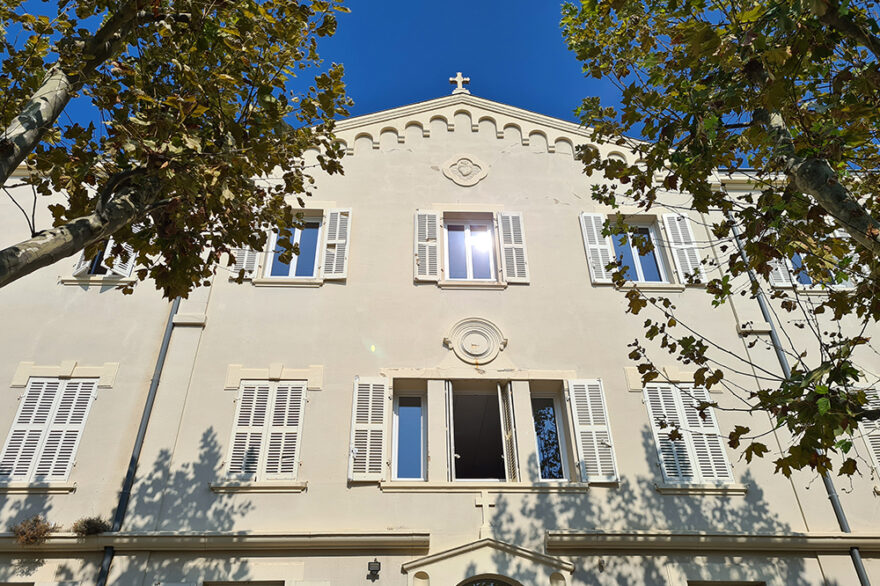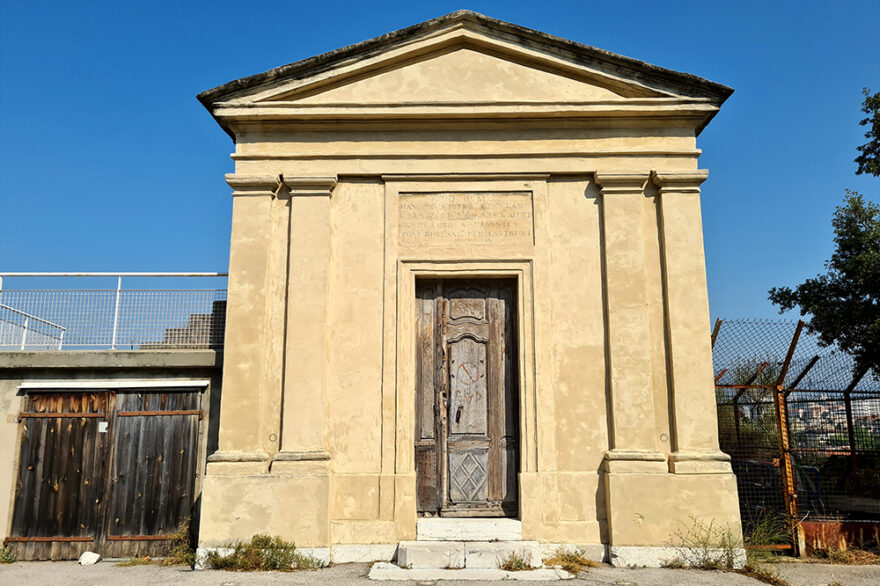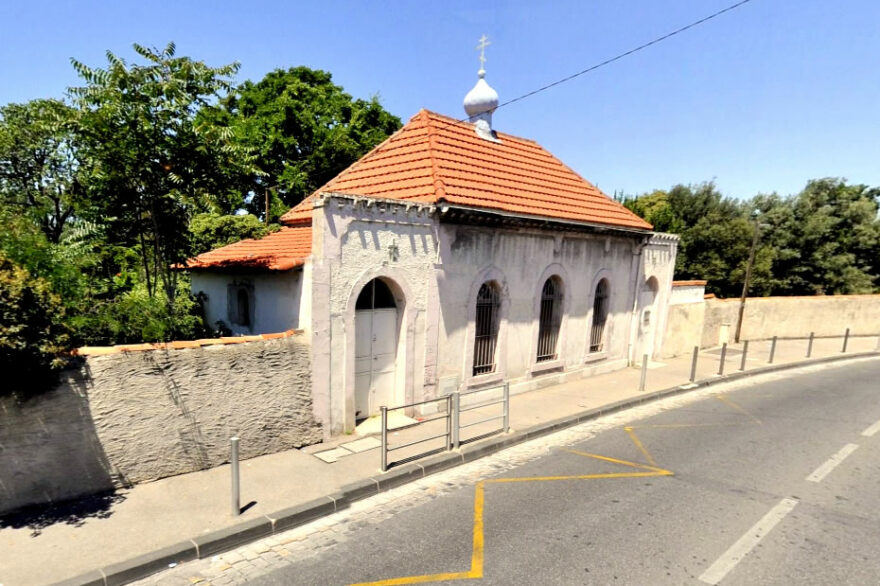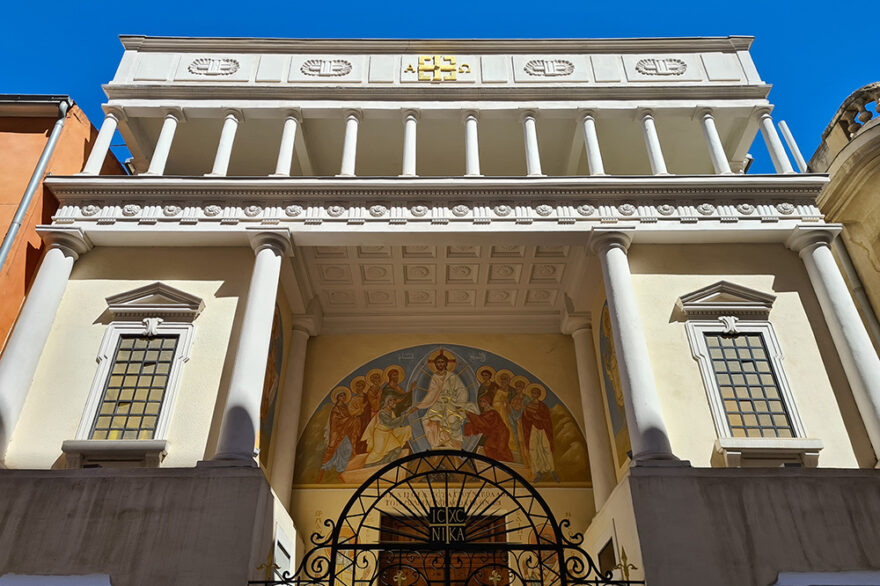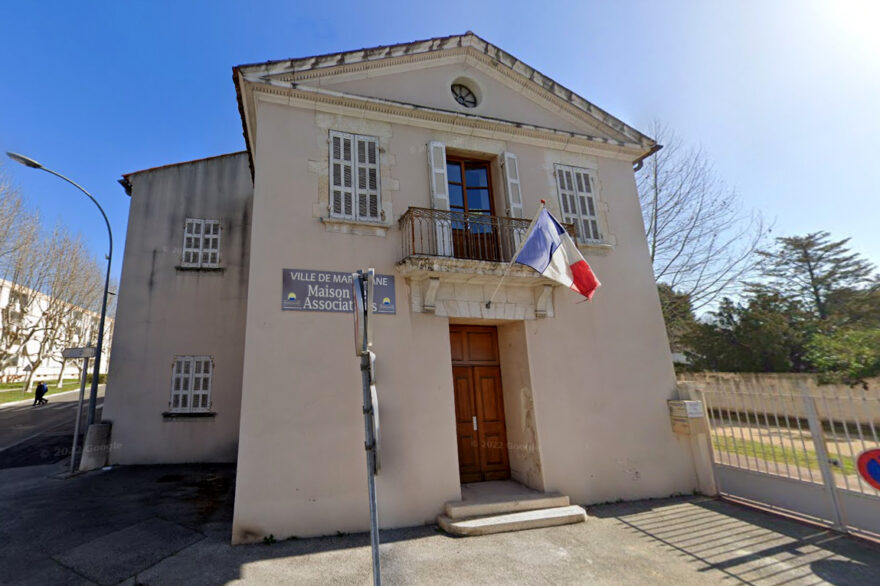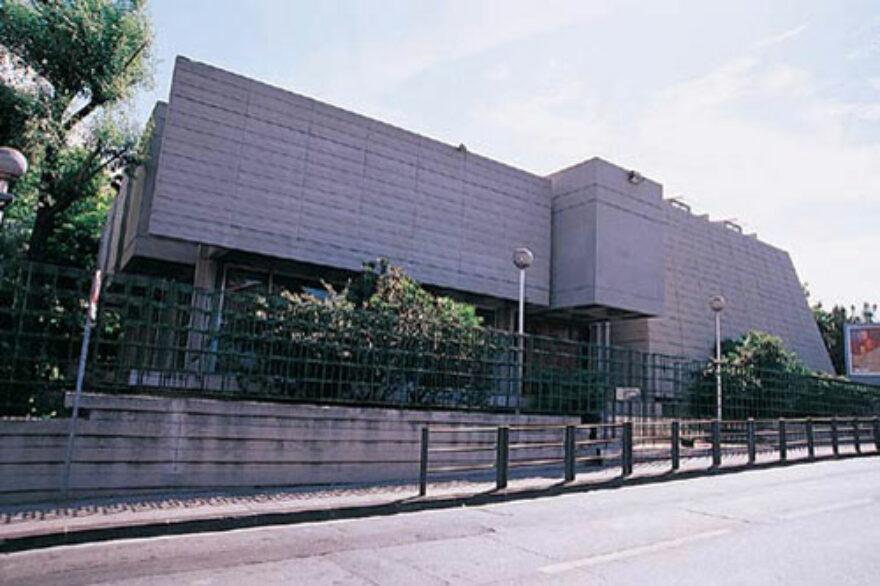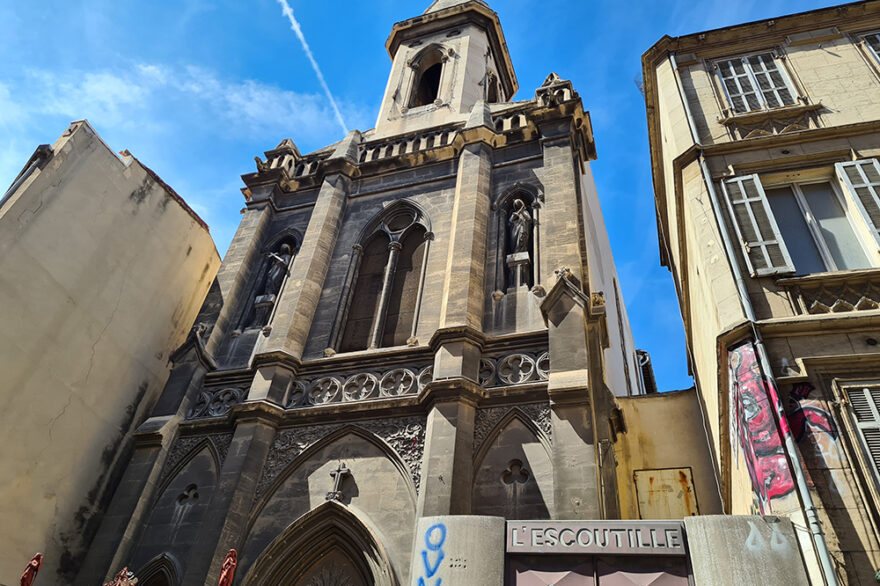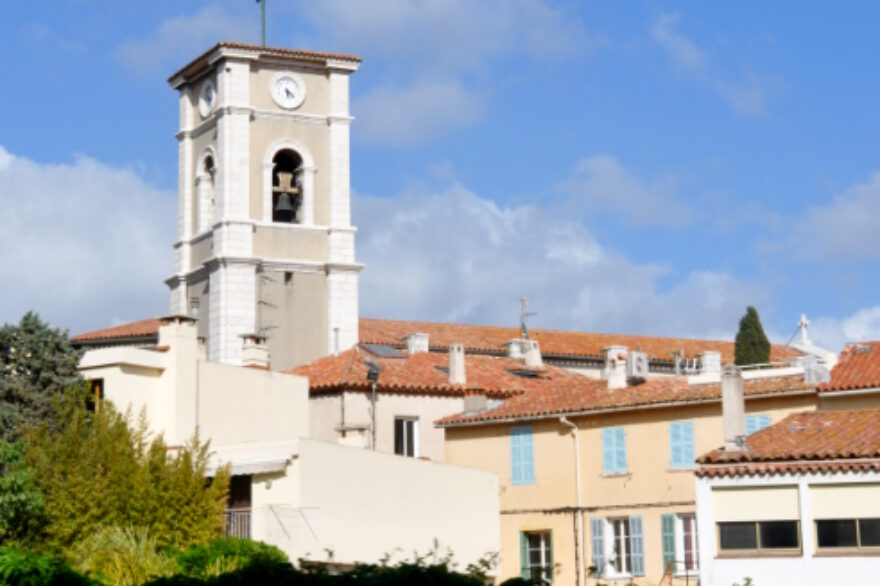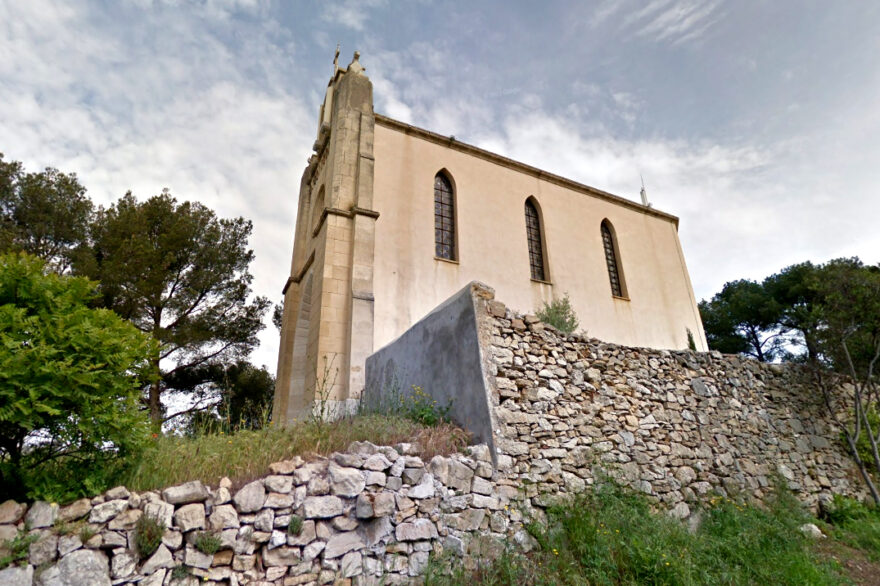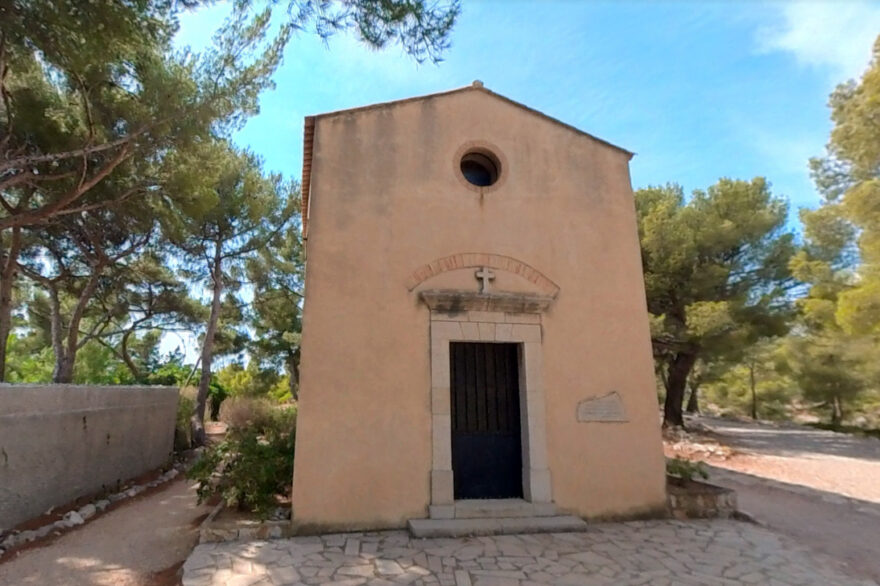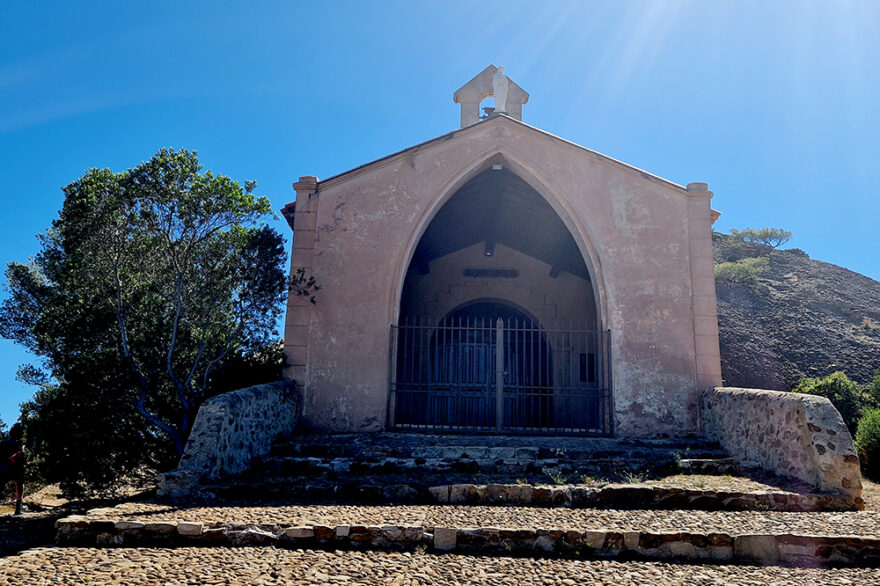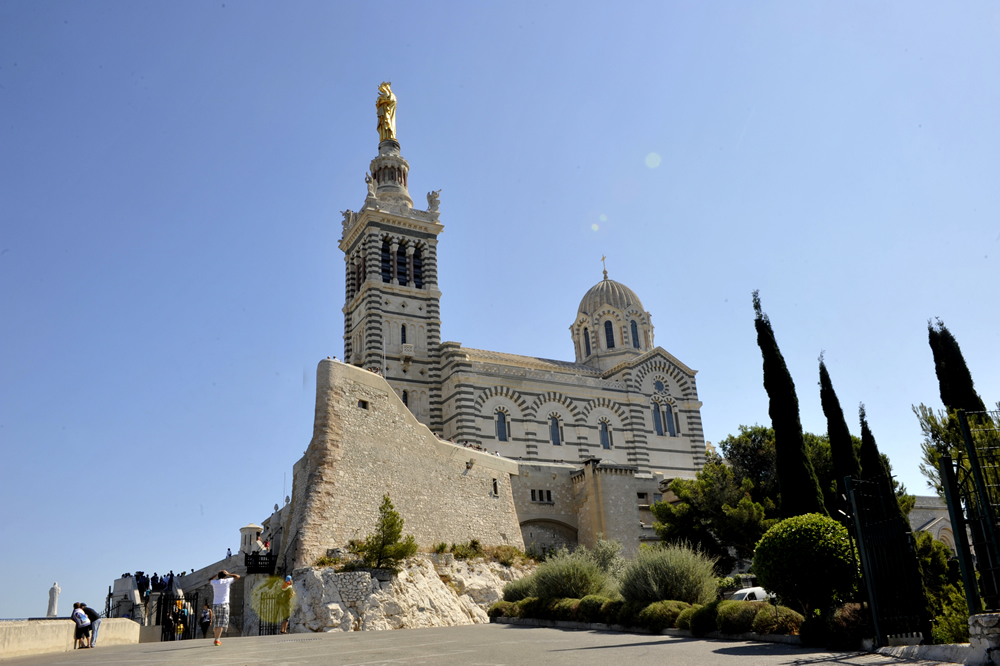
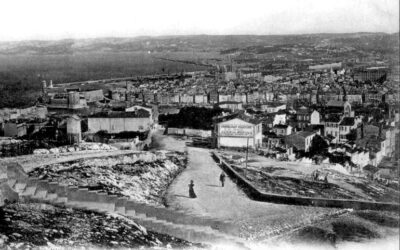 A small chapel on a hill
A small chapel on a hill
In 1214, the year of the Battle of Bouvines and the birth of King Saint Louis, a priest from Marseilles, named Pierre, had a small sanctuary dedicated to the Virgin Mary built on the rocky triangle constituting the top of a 161m hill facing to the city of Marseille, then very small. The hill being called “La Garde”, the sanctuary was quite naturally called Notre-Dame de la Garde. At the origin of this chapel, there was therefore neither apparition nor miracle: it was born from the devotion of a priest. In 1477, it was slightly enlarged. But it remained very small, being able to contain at most fifty to sixty people.
In the XNUMXth century, the chapel was included in a fort
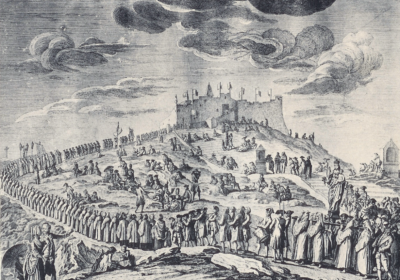 In January 1516, after his famous victory of 1515 at Marignan in northern Italy, young King Francis I passed through Marseilles for the first time, where his wife and mother joined him. He did not fail to go up to make his devotions in the chapel of Notre-Dame de la Garde. Being interested, as king, in the problems of defense, he noted with regret that the town of Marseilles was very badly defended. It was surrounded by a very modest wall, but it had no fort, whereas many other French towns already had one. Moreover, this could be explained very well since Provence had only been united with France in 1481, i.e. only thirty-five years earlier, and the kings of France - because it was always them who had the strong – had not yet had the opportunity to build any in Marseilles. François I went back to Paris saying to himself that one day the defense of the city should be strengthened.
In January 1516, after his famous victory of 1515 at Marignan in northern Italy, young King Francis I passed through Marseilles for the first time, where his wife and mother joined him. He did not fail to go up to make his devotions in the chapel of Notre-Dame de la Garde. Being interested, as king, in the problems of defense, he noted with regret that the town of Marseilles was very badly defended. It was surrounded by a very modest wall, but it had no fort, whereas many other French towns already had one. Moreover, this could be explained very well since Provence had only been united with France in 1481, i.e. only thirty-five years earlier, and the kings of France - because it was always them who had the strong – had not yet had the opportunity to build any in Marseilles. François I went back to Paris saying to himself that one day the defense of the city should be strengthened.
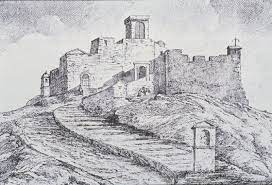 The opportunity will be quickly given to him since Charles-Quint, emperor of the Holy Roman Empire, then sought to seize the south of France to unite the two parts of his Empire (Central Europe and Spain ). He besieged Marseilles in 1524. He failed to take the city. But François I then returned to Provence and decided to build two forts in Marseille: one on the island of If (the famous Chateau d'If) and the other on the top of the Garde hill where the chapel was located. In white, the parts intended for the governor and the garrison. It is therefore now included in the fort. A fort which received the name of "fort Notre-Dame de la Garde". Logically, it should have been closed to the public, because the chapels of the forts were obviously for the exclusive use of the soldiers of the garrison.
The opportunity will be quickly given to him since Charles-Quint, emperor of the Holy Roman Empire, then sought to seize the south of France to unite the two parts of his Empire (Central Europe and Spain ). He besieged Marseilles in 1524. He failed to take the city. But François I then returned to Provence and decided to build two forts in Marseille: one on the island of If (the famous Chateau d'If) and the other on the top of the Garde hill where the chapel was located. In white, the parts intended for the governor and the garrison. It is therefore now included in the fort. A fort which received the name of "fort Notre-Dame de la Garde". Logically, it should have been closed to the public, because the chapels of the forts were obviously for the exclusive use of the soldiers of the garrison.
But François I decided that in times of peace the faithful could access the chapel by using the drawbridge which, during the day, the soldiers would keep in a low position. The roof covers both the chapel and the adjoining rooms.
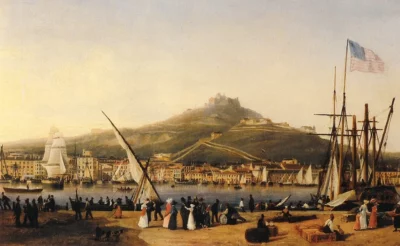 According to the best fort historians, this is a unique case in the world: no other example of a sanctuary open to the public located inside a working fort is known. And this situation lasted for more than four centuries since, as we will see, the fort was not demilitarized until 1934. From the end of the 1588th century, many sailors were seen going up to Notre-Dame de la Garde. Until then, they went to pray in front of the statue of Notre-Dame de la Mer in the Saint-Etienne church located where the Notre-Dame du Mont church is currently located. But, in 21, this church was demolished and the sailors then got into the habit of coming to Notre-Dame de la Garde to pray there and leave numerous ex-votos there. During the French Revolution, after the execution of Louis XVI on January 1793, XNUMX, members of the Bourbon family were imprisoned for six months in the fort of Notre-Dame de la Garde.
According to the best fort historians, this is a unique case in the world: no other example of a sanctuary open to the public located inside a working fort is known. And this situation lasted for more than four centuries since, as we will see, the fort was not demilitarized until 1934. From the end of the 1588th century, many sailors were seen going up to Notre-Dame de la Garde. Until then, they went to pray in front of the statue of Notre-Dame de la Mer in the Saint-Etienne church located where the Notre-Dame du Mont church is currently located. But, in 21, this church was demolished and the sailors then got into the habit of coming to Notre-Dame de la Garde to pray there and leave numerous ex-votos there. During the French Revolution, after the execution of Louis XVI on January 1793, XNUMX, members of the Bourbon family were imprisoned for six months in the fort of Notre-Dame de la Garde.
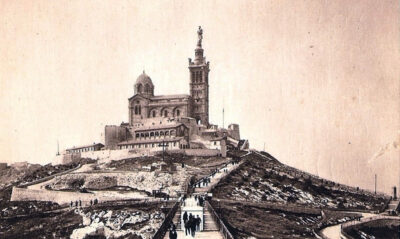 Catholic worship was banned in France in November of the same year. The State seized all the religious buildings. Everything that the chapel contained then disappeared: the two statues of the Virgin (one in wood dating from the 1651th century and the other in silver from 1807), the bells, the altars, the ex-votos... Alone remained in the chapel a very large and beautiful crucifix that can be seen in the crypt on the right as you enter. According to some specialists, it dates from the first half of the XNUMXth century. Following the Revolution, worship resumed at Notre-Dame de la Garde in XNUMX. Joseph-Elie Escaramagne, a former sailor, donated to the sanctuary a statue of the Virgin bought at an auction: it is the statue of the "Virgin with the bouquet" that can be seen behind the altar of the crypt. For his part, the commander of the fort offered the chapel a small bell.
Catholic worship was banned in France in November of the same year. The State seized all the religious buildings. Everything that the chapel contained then disappeared: the two statues of the Virgin (one in wood dating from the 1651th century and the other in silver from 1807), the bells, the altars, the ex-votos... Alone remained in the chapel a very large and beautiful crucifix that can be seen in the crypt on the right as you enter. According to some specialists, it dates from the first half of the XNUMXth century. Following the Revolution, worship resumed at Notre-Dame de la Garde in XNUMX. Joseph-Elie Escaramagne, a former sailor, donated to the sanctuary a statue of the Virgin bought at an auction: it is the statue of the "Virgin with the bouquet" that can be seen behind the altar of the crypt. For his part, the commander of the fort offered the chapel a small bell.
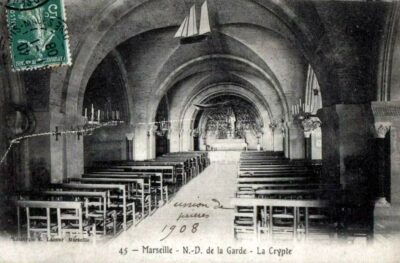 Since the 1837th century, the population of Marseilles had greatly increased. The chapel was really too small and the people in charge of the sanctuary wanted to enlarge it a little. But, since the time of Francis I, the whole top of the hill was military land and these officials were only the tenants of the chapel. It was the French State that owned it and it was the Minister of War who managed the estate. So they wrote to him to ask him if he would agree to let them rent two small rooms which adjoined the sanctuary and which, until then, had been used by the garrison. The Minister gave a favorable opinion. The party wall was therefore knocked down and the chapel became a little larger. In XNUMX, those responsible for the sanctuary installed in the chapel, in place of the statue of the Virgin with the bouquet, a silver statue of the Virgin which they had commissioned from the artist Chanuel to replace the one which, at the time of the Revolution, had been sent to the cast iron. It is the one that currently dominates the main altar of the basilica.
Since the 1837th century, the population of Marseilles had greatly increased. The chapel was really too small and the people in charge of the sanctuary wanted to enlarge it a little. But, since the time of Francis I, the whole top of the hill was military land and these officials were only the tenants of the chapel. It was the French State that owned it and it was the Minister of War who managed the estate. So they wrote to him to ask him if he would agree to let them rent two small rooms which adjoined the sanctuary and which, until then, had been used by the garrison. The Minister gave a favorable opinion. The party wall was therefore knocked down and the chapel became a little larger. In XNUMX, those responsible for the sanctuary installed in the chapel, in place of the statue of the Virgin with the bouquet, a silver statue of the Virgin which they had commissioned from the artist Chanuel to replace the one which, at the time of the Revolution, had been sent to the cast iron. It is the one that currently dominates the main altar of the basilica.
A few years later, those in charge of the sanctuary considered that the small bell offered in 1807 by the commander of the fort was very small. But, really going from one extreme to the other, in 1842 they commissioned a founder from Lyon for this tiny chapel (and there was no question then of building the larger sanctuary that we know) a drone of 8 kg which will be installed on the chapel in October 234. There was certainly nowhere in the world such a small chapel with such a big bell!
The construction of a new sanctuary (1853-1897)
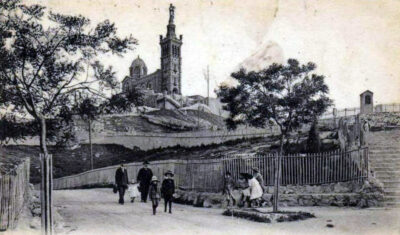 In 1851, the administrators of Notre-Dame de la Garde asked the Minister of War – without really hoping for a positive response – for authorization to demolish the small chapel and replace it with a larger sanctuary surmounted by a high bell tower: like the chapel, this new sanctuary would also be located inside the fort. Despite the objections of certain officers who feared that the structure of the new sanctuary would harm the defensive value of the fort, the advisers of the Minister issued a favorable opinion and the latter gave his agreement on February 5, 1852. The officials of Notre-Dame de the Guard asked architects to draw up the plans for the new sanctuary. They had to choose between two projects: a neo-Gothic style church and a neo-Romanesque style church.
In 1851, the administrators of Notre-Dame de la Garde asked the Minister of War – without really hoping for a positive response – for authorization to demolish the small chapel and replace it with a larger sanctuary surmounted by a high bell tower: like the chapel, this new sanctuary would also be located inside the fort. Despite the objections of certain officers who feared that the structure of the new sanctuary would harm the defensive value of the fort, the advisers of the Minister issued a favorable opinion and the latter gave his agreement on February 5, 1852. The officials of Notre-Dame de the Guard asked architects to draw up the plans for the new sanctuary. They had to choose between two projects: a neo-Gothic style church and a neo-Romanesque style church.
It was this second project that was selected. And, as the basilica was once adorned with Byzantine-inspired mosaics, it is generally said to be Romano-Byzantine. The architect was Jacques Henri Esperandieu : he was then only twenty-three years old… and he was of Protestant faith.
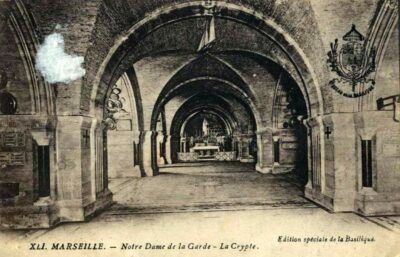 The first stone was laid on September 11, 1853 by the Bishop of Marseille, Mgr Eugène de Mazenod. The faithful made donations to finance the construction. But, during the first years, the money often ran out and, several times, work had to be interrupted. After eight years of construction, on the death of Bishop de Mazenod in 1861, the digging of the crypt in the rock had been completed, but, of the upper church, only the side walls and the base of the bell tower were built. It therefore remained to build the vault of the nave, the dome and most of the bell tower. The successor of Bishop Patrice Cruice accelerated the work and, on June 4, 1864, the sanctuary could be consecrated, with an unfinished bell tower, by Cardinal Villecourt, a member of the Roman Curia surrounded by forty-one bishops. The construction of the bell tower continued. And, in 1866, we were able to install the staff there, the size of which was now much better proportioned to the dimensions of the sanctuary, and we began to build the pedestal of the monumental statue.
The first stone was laid on September 11, 1853 by the Bishop of Marseille, Mgr Eugène de Mazenod. The faithful made donations to finance the construction. But, during the first years, the money often ran out and, several times, work had to be interrupted. After eight years of construction, on the death of Bishop de Mazenod in 1861, the digging of the crypt in the rock had been completed, but, of the upper church, only the side walls and the base of the bell tower were built. It therefore remained to build the vault of the nave, the dome and most of the bell tower. The successor of Bishop Patrice Cruice accelerated the work and, on June 4, 1864, the sanctuary could be consecrated, with an unfinished bell tower, by Cardinal Villecourt, a member of the Roman Curia surrounded by forty-one bishops. The construction of the bell tower continued. And, in 1866, we were able to install the staff there, the size of which was now much better proportioned to the dimensions of the sanctuary, and we began to build the pedestal of the monumental statue.
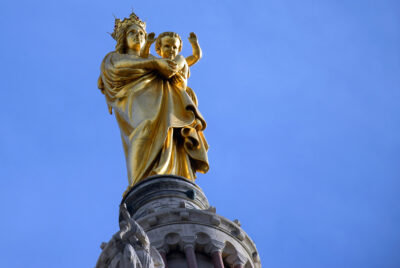 The work of Eugène Lequesne, it is not in solid metal, but was produced by the Christofle company – which still exists – using a process that was new at the time: electroplating. Latex molds were made of the four sections. They were plunged into a bath of copper sulphate and, by electrolysis, a few millimeters of copper were deposited on these moulds. Manufactured in Paris, these sections arrived in Marseilles by rail in December 1869. They were gilded with gold leaf. In May-June 1870, they were hoisted to the top of the bell tower and fixed to the metal carcass that had been put in place. Since then, the statue has been gilded approximately every twenty-five years. 11,20 m high, it weighs 9 kg. It remained to carry out all the interior finishes. In 796, the floor mosaic of the choir was laid and then the floor mosaic of the nave.
The work of Eugène Lequesne, it is not in solid metal, but was produced by the Christofle company – which still exists – using a process that was new at the time: electroplating. Latex molds were made of the four sections. They were plunged into a bath of copper sulphate and, by electrolysis, a few millimeters of copper were deposited on these moulds. Manufactured in Paris, these sections arrived in Marseilles by rail in December 1869. They were gilded with gold leaf. In May-June 1870, they were hoisted to the top of the bell tower and fixed to the metal carcass that had been put in place. Since then, the statue has been gilded approximately every twenty-five years. 11,20 m high, it weighs 9 kg. It remained to carry out all the interior finishes. In 796, the floor mosaic of the choir was laid and then the floor mosaic of the nave.
Between 1882 and 1884, the first ornamental mosaics were laid: that of the cul-de-four of the apse with its admirable birds and, below, nine medallions illustrating as many invocations of the litanies of the Blessed Virgin.
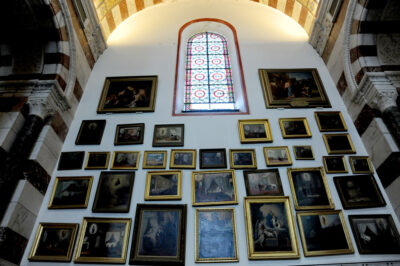 In 1884, the provisional high altar was destroyed by fire and we then began to build the high altar that we know today. It was consecrated on April 26, 1886 by Cardinal Lavigerie, Archbishop of Algiers, who, then a young bishop of Nancy, had attended the consecration of the sanctuary in June 1864. He was very well known at Notre-Dame de la Garde, because he passed there on each return trip of his many trips between Algiers and France. Between 1890 and 1892, the other mosaics were laid: in the rest of the choir, inside the large cupola, in the three cupolas which form the vault of the nave. Inside the basilica, only the side walls are not covered with mosaics. These occupy an area of 1m² and include more than twelve million tesserae (as the elements of a mosaic are called). These mosaics are magnificent because those who designed them were inspired by very beautiful mosaics from the 200th and XNUMXth centuries found in Rome and Ravenna.
In 1884, the provisional high altar was destroyed by fire and we then began to build the high altar that we know today. It was consecrated on April 26, 1886 by Cardinal Lavigerie, Archbishop of Algiers, who, then a young bishop of Nancy, had attended the consecration of the sanctuary in June 1864. He was very well known at Notre-Dame de la Garde, because he passed there on each return trip of his many trips between Algiers and France. Between 1890 and 1892, the other mosaics were laid: in the rest of the choir, inside the large cupola, in the three cupolas which form the vault of the nave. Inside the basilica, only the side walls are not covered with mosaics. These occupy an area of 1m² and include more than twelve million tesserae (as the elements of a mosaic are called). These mosaics are magnificent because those who designed them were inspired by very beautiful mosaics from the 200th and XNUMXth centuries found in Rome and Ravenna.
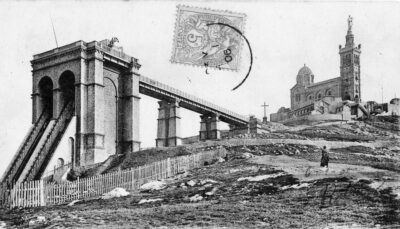 To facilitate the ascent of the faithful to Notre-Dame de la Garde, several engineers had, from 1868, presented to the municipality projects for funicular railways passing through the streets of Marseilles. But these projects did not succeed, because, in such an area, the legislation was rather vague and the mayor did not really know whether the authorization was up to him or to the prefect. It was then that in 1889 the engineer Emile Maslin grilled everyone's politeness. Inspired by Elevators fitted out in the Eiffel Tower which had just been built in Paris, he had the idea of building an elevator which would rise almost vertically along the wall of an old quarry. This engineer got along with Jean-Elie Dussaud, the owner of the land where the departure station was to be built.
To facilitate the ascent of the faithful to Notre-Dame de la Garde, several engineers had, from 1868, presented to the municipality projects for funicular railways passing through the streets of Marseilles. But these projects did not succeed, because, in such an area, the legislation was rather vague and the mayor did not really know whether the authorization was up to him or to the prefect. It was then that in 1889 the engineer Emile Maslin grilled everyone's politeness. Inspired by Elevators fitted out in the Eiffel Tower which had just been built in Paris, he had the idea of building an elevator which would rise almost vertically along the wall of an old quarry. This engineer got along with Jean-Elie Dussaud, the owner of the land where the departure station was to be built.
As it was a purely private matter, the lift was built legally without it being necessary to seek authorization from the public authorities!… It operated from 1892 to 1967 and was demolished in 1974.
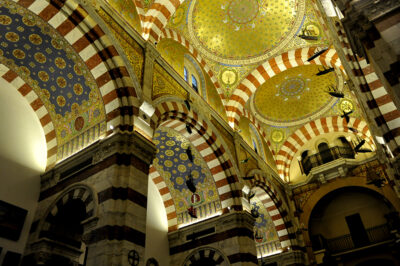 The construction of the basilica ended with the installation, in 1897, of the heavy bronze doors. In 1914, great celebrations were organized to mark the 7th centenary of the sanctuary of Notre-Dame de la Garde and the 50th anniversary of the consecration of the basilica. But this date also obviously evokes the beginning of the First World War, a war which, curiously, happens to have been an important date in the history of our sanctuary. For the first time, in fact, tanks and planes had been used in a war. In the aftermath of this war, the General Staff realized that the forts built between the XNUMXth and XNUMXth centuries would henceforth prove useless.
The construction of the basilica ended with the installation, in 1897, of the heavy bronze doors. In 1914, great celebrations were organized to mark the 7th centenary of the sanctuary of Notre-Dame de la Garde and the 50th anniversary of the consecration of the basilica. But this date also obviously evokes the beginning of the First World War, a war which, curiously, happens to have been an important date in the history of our sanctuary. For the first time, in fact, tanks and planes had been used in a war. In the aftermath of this war, the General Staff realized that the forts built between the XNUMXth and XNUMXth centuries would henceforth prove useless.
There was therefore no reason to continue to incur expenses to maintain them. It was better to demilitarize and alienate them.
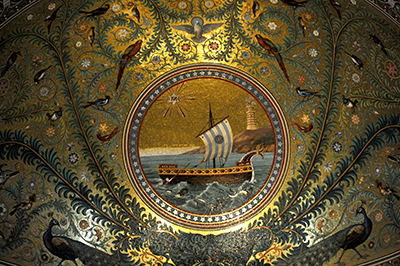 The bishopric of Marseilles showed interest, because those in charge of the sanctuary did not then have any room to bring together the faithful outside the basilica and the crypt. Indeed, as long as the fort interested the Army, the Minister of War would not have authorized them to build buildings against the outer walls of this fort that would have harmed its defensive value. The representatives of the diocese and those of the Army met and, very quickly, they agreed on an exchange: the Army would give the diocese all the top of the hill of the Guard and would receive from the bishopric a house located in the center of Marseille. But the legal file was very complex, because several ministries were concerned and it progressed very slowly. It was on May 3, 1934 that the President of the Republic signed the decree of "decommissioning", that is to say the demilitarization of the fort.
The bishopric of Marseilles showed interest, because those in charge of the sanctuary did not then have any room to bring together the faithful outside the basilica and the crypt. Indeed, as long as the fort interested the Army, the Minister of War would not have authorized them to build buildings against the outer walls of this fort that would have harmed its defensive value. The representatives of the diocese and those of the Army met and, very quickly, they agreed on an exchange: the Army would give the diocese all the top of the hill of the Guard and would receive from the bishopric a house located in the center of Marseille. But the legal file was very complex, because several ministries were concerned and it progressed very slowly. It was on May 3, 1934 that the President of the Republic signed the decree of "decommissioning", that is to say the demilitarization of the fort.
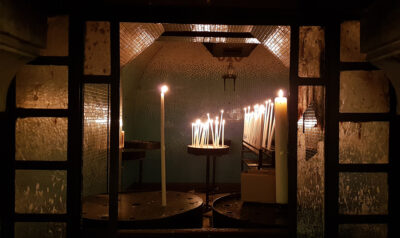 In 1936, even before the signing of the act of exchange, the diocese began, with the consent of the civil authorities, to build along the walls of the fort (sea side) a building intended to house the nuns attached to the sanctuary. While these legal proceedings were taking place, the celebrations for the coronation of the statue of Notre-Dame de la Garde had attracted to Marseilles for four days in June 1931 forty-nine bishops and 300 people. Pope Pius XI had sent as legate to preside over these celebrations Cardinal Louis Maurin, Archbishop of Lyon and former rector of Notre-Dame de la Garde. The date of these festivities was chosen to mark the 000th centenary of the Ecumenical Council of Ephesus (June 15) which declared that the Virgin Mary could be called "Mother of God".
In 1936, even before the signing of the act of exchange, the diocese began, with the consent of the civil authorities, to build along the walls of the fort (sea side) a building intended to house the nuns attached to the sanctuary. While these legal proceedings were taking place, the celebrations for the coronation of the statue of Notre-Dame de la Garde had attracted to Marseilles for four days in June 1931 forty-nine bishops and 300 people. Pope Pius XI had sent as legate to preside over these celebrations Cardinal Louis Maurin, Archbishop of Lyon and former rector of Notre-Dame de la Garde. The date of these festivities was chosen to mark the 000th centenary of the Ecumenical Council of Ephesus (June 15) which declared that the Virgin Mary could be called "Mother of God".
1941: the bishopric of Marseille becomes the owner of the top of the hill
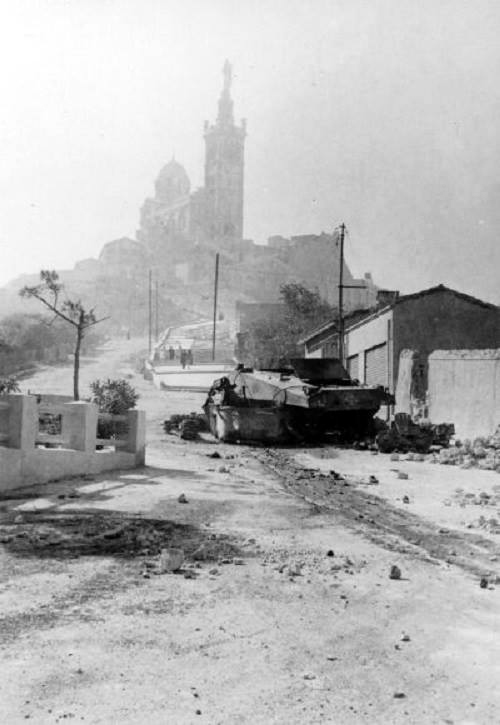
Armored Joan of Arc
It was on July 21, 1941 that, before the Prefect of Bouches-du-Rhône, the act of exchange was signed by representatives of the State and by Bishop Louis Borel who was both Vicar General of the diocese and rector of Notre-Dame de la Garde. France was then governed by Marshal Pétain, but, in this case, it was in no way a question of a favor granted by the Government. Indeed, the deed of exchange was ready in 1939, therefore under the Third Republic, and the signing should have taken place then. But a new world war had just broken out and this affair, which seemed quite secondary, was postponed until later. On that day, the State gave the diocese the 61 m² of the top of the hill and received from the bishopric a two-storey house located in the Montevideo cul-de-sac, with a total area of 839 m², as well as a a sum of 1 F. Contrary to what one is tempted to think, the State did not lose in the exchange, because, the site being classified, the land at the top of the hill of the Guard has no market value. The State was even very profitable since in 380 it was able to resell very expensively to a promoter the small house of the impasse Montevideo which was replaced by a building of several floors. But the unfolding of the story sometimes presents surprises. The Army left in 35, abandoning the fort and three barracks outside the fort. A year later, in November 000, the Germans invaded the southeastern zone of France. In Marseilles, they take position in a certain number of places and, in particular, German soldiers settle in the barracks of the hill of the Guard which the French soldiers had just left!
And, paradoxically, the buildings – which however lost their military use ten years ago – were to find themselves involved in August 1944 in much tougher fighting than that which they had known since the XNUMXth century.
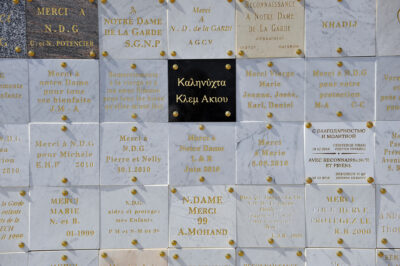 On August 25, 1944, the sanctuary was liberated from German occupation by a section of the 1st company of the 7th Regiment of Algerian Tirailleurs. A few hours earlier, a tank of the 1st Armored Division had received a shell fired by the Germans from Notre-Dame de la Garde and its three occupants were charred to death. The next two days, the Germans, still present in various places in Marseilles, fired heavily on the basilica which they knew was in the hands of the Algerian Tirailleurs. Hit at its base by shells, the steeple nearly collapsed. You can still see, on some exterior walls of the basilica, some impacts of shrapnel.
On August 25, 1944, the sanctuary was liberated from German occupation by a section of the 1st company of the 7th Regiment of Algerian Tirailleurs. A few hours earlier, a tank of the 1st Armored Division had received a shell fired by the Germans from Notre-Dame de la Garde and its three occupants were charred to death. The next two days, the Germans, still present in various places in Marseilles, fired heavily on the basilica which they knew was in the hands of the Algerian Tirailleurs. Hit at its base by shells, the steeple nearly collapsed. You can still see, on some exterior walls of the basilica, some impacts of shrapnel.
Between 1950 and 1961, the bishopric of Marseilles built two buildings along the walls of the fort facing the city: the reception hall crowned by the store and a building comprising, on the ground floor, a large room and , upstairs, a room that first became a cafeteria, then a restaurant.
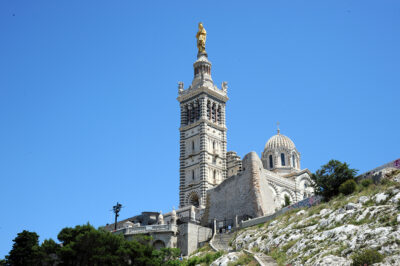 Three quarters of the walls of the fort of François I are still in place. But a large part of them are hidden by the buildings built by the diocese on either side of the fort. Only the large bastion that can be seen on the right when looking at the basilica from the front and a very slender bastion located at the back of the sanctuary remain visible. The drawbridge, installed by the Army in 1879 in front of the entrance to the crypt to replace the old drawbridge that had to be demolished during the construction of the new sanctuary, is still in place. The guardians of Notre-Dame raise it every evening and lower it every morning: the sanctuary is thus isolated as in the past the Army isolated the fort.
Three quarters of the walls of the fort of François I are still in place. But a large part of them are hidden by the buildings built by the diocese on either side of the fort. Only the large bastion that can be seen on the right when looking at the basilica from the front and a very slender bastion located at the back of the sanctuary remain visible. The drawbridge, installed by the Army in 1879 in front of the entrance to the crypt to replace the old drawbridge that had to be demolished during the construction of the new sanctuary, is still in place. The guardians of Notre-Dame raise it every evening and lower it every morning: the sanctuary is thus isolated as in the past the Army isolated the fort.
People who go up to the basilica by the external stairs pass over this drawbridge, sometimes without realizing it...
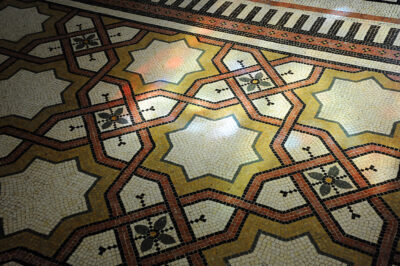 Between 2000 and 2008, under the direction of the architect Xavier David, major works were undertaken for the restoration of the sanctuary. First of all exterior works: in particular, it was necessary to replace the green stones which, due to pollution, had partly decomposed. Work was then carried out inside the sanctuaries: the marbles of the basilica and the stones of the crypt were cleaned and the mosaics, some of which had lost tesserae because of the bombardments of August 1944, were restored by a team of mosaicists directed by Michel Patrizio. And the lighting system has been greatly improved, showcasing our beautiful mosaics.
Between 2000 and 2008, under the direction of the architect Xavier David, major works were undertaken for the restoration of the sanctuary. First of all exterior works: in particular, it was necessary to replace the green stones which, due to pollution, had partly decomposed. Work was then carried out inside the sanctuaries: the marbles of the basilica and the stones of the crypt were cleaned and the mosaics, some of which had lost tesserae because of the bombardments of August 1944, were restored by a team of mosaicists directed by Michel Patrizio. And the lighting system has been greatly improved, showcasing our beautiful mosaics.
